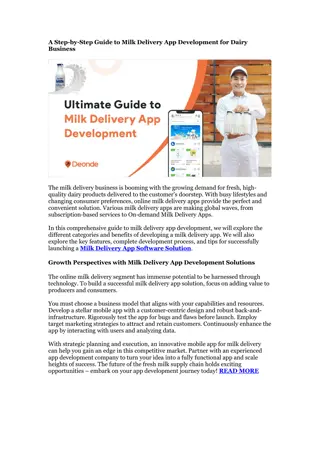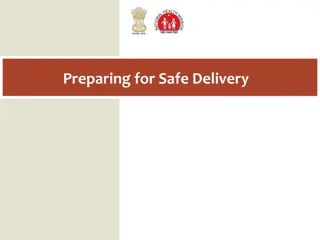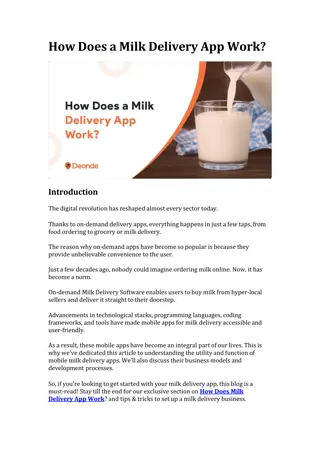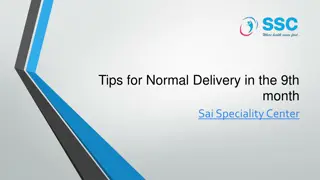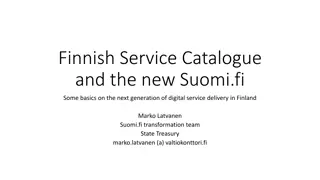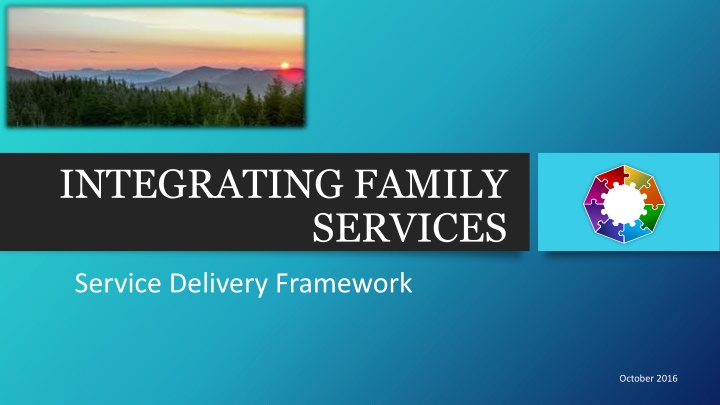
Integrating Family Services Delivery Framework Overview
Explore the service delivery framework for integrating family services, providing guidance on design, innovation, and flexibility for regions utilizing the IFS approach. Learn about the intended audience, core values, guiding principles, and state & local service delivery implementation. This document aims to ensure consistency in service delivery while allowing adaptation to the unique needs of children, youth, and families.
Download Presentation

Please find below an Image/Link to download the presentation.
The content on the website is provided AS IS for your information and personal use only. It may not be sold, licensed, or shared on other websites without obtaining consent from the author. If you encounter any issues during the download, it is possible that the publisher has removed the file from their server.
You are allowed to download the files provided on this website for personal or commercial use, subject to the condition that they are used lawfully. All files are the property of their respective owners.
The content on the website is provided AS IS for your information and personal use only. It may not be sold, licensed, or shared on other websites without obtaining consent from the author.
E N D
Presentation Transcript
INTEGRATING FAMILY SERVICES Service Delivery Framework October 2016
http://universidadeslectoras.org/7aniversario/img/Imagen-investigacion.jpghttp://universidadeslectoras.org/7aniversario/img/Imagen-investigacion.jpg TABLE OF CONTENTS Introduction Audience Intended Uses Definitions IFS Service Delivery Framework IFS Guiding Principles Implementation of Service Delivery Core Values Statewide Approaches Required Core Supports and Services Promotion and Prevention Strategies Innovative Practices For More Information 2
INTRODUCTION Audience This document is intended primarily for community partners in prospective or current regions using an IFS approach. This includes IFS grantees, IFS Core Team members, and IFS Regional Council members. It is also meant to provide interested stakeholders (e.g. legislators, families, service providers, state agency staff) with a deeper understanding of what the local and state service delivery element of the IFS model is intended to look like on the ground. 3
INTRODCTION Intended Uses This document provides guidance to pre-IFS and IFS regions regarding service delivery design and re-design. Similar to the IFS collaborative leadership framework, this framework attempts to strike a balance between providing enough parameters to ensure consistency among regions regarding available supports and services for children, youth and families while also giving communities enough flexibility to respond to the particular needs of children, youth and families as identified by IFS Regional Councils. In this context, flexibility lies in how much of a support or service is provided, not in what is provided. 4
IFS MODEL State & Local Service Delivery This framework translates the State and Local Service Delivery element of the IFS model into practice by: Articulating the thinking that guides service delivery in IFS regions Encouraging local innovative practices wherever possible Sharing responsibility for outcomes State & Local Service Delivery AHS Regional Outcomes Report is a companion document to this framework. It ties state and local service delivery to the other elements of the IFS model in a concrete and specific way. 5
IFS MODEL IFS Guiding Principles 6 These guiding principles give life and form to Integrating Family Services vision and mission. They also guide service delivery at the community level. Promote the well-being of Vermont s children, youth and families. Policies, services and service providers are sensitive and responsive to the unique aspects of each family. Build communities capacity to provide a full range of resources in a flexible and timely way that is responsive to the needs of children and youth (prenatal through age 22) and families. Focus on the individual and the family. Understand the child's needs in the context of his/her family. Ensure that families voices inform processes, plans and policies. Adopt the Strengthening Families approach. Strengthening Families five protective factors guide our work. Invest in a skilled, competent and valued workforce. People working with children, youth and families need training, support and adequate compensation. Balance innovation with families experiences, research and data to inform decisions about how to best use available resources and achieve positive outcomes. Assure continuous quality improvement. Data informs decisions and drives change at the state and local level. Promote a common language, shared decision-making and cross-disciplinary team work. 6
IFS MODEL Implementation of Service Delivery When implementing the IFS model it is important to take an incremental approach to increasing communities ability to work together in sharing responsibility for children and families. As an innovative approach to human service delivery that seeks integration of service delivery systems at the state and community level, IFS requires a high level of collaboration. This is achieved over time, as people work together to implement the IFS model in their community with increasing levels of trust. The culture of service delivery in an IFS region is as important as the supports and services themselves. This is what makes IFS feel and look different from past ways of operating. Developing the culture we desire takes time, depends upon strong working relationships and requires an investment in workforce development to build the skills required by high degrees of collaboration, effective governance, and shared accountability. The outcomes measured will tell us areas of success and where we need to invest more time and resources. Strong teaming relationships locally and with state partners are imperative to effectively meeting the needs of children, youth and families. 7
IFS Service Delivery Framework Innovative Practices The IFS service delivery framework is comprised of: Required Core Services and Supports Statewide Approaches IFS Model- Guiding principles Promotion and Prevention Core Values 8
CORE VALUES Integrating Family Services is an approach to IFS human service delivery that is based on the following core values: Child-Centered, Family-Focused Collaboration Between and Among Families, Agencies and Community Individualized Family-Driven Strength-Based Culturally Competent Community-Based Model- Guiding principles Core Values 9
Statewide Approaches The IFS service delivery framework: Keeps the needs of all Vermonters in mind; Emphasizes promotion of healthy child, youth and family development as well as prevention as the most effective strategies for ensuring the well-being of Vermont s children, youth and families; Accounts for the need for intervention, treatment, services and supportsat critical times in a person s life; Recognizes some Vermonters, such as those with developmental disabilities, will need community supports throughout their lifetime. Reflects Strengthening Families, Youth Thrive and Bright Futures Frameworks Statewide Approaches IFS Model- Guiding principles 10
Statewide Approaches Strengthening Families is a research-informed approach to increase family strengths, enhance child development and reduce the likelihood of child abuse and neglect. This framework, which was developed by the Center for the Study of Social Policy, is based on engaging families, programs and communities in building five protective factors: Youth Thrive is both a research-informed framework based on a synthesis of research on positive youth development, resilience, neuroscience, stress and impact of trauma on brain development and the name of the Center for the Study of Social Policy s national initiative to improve the well-being outcomes of all youth (ages 9- 26), with a particular focus on youth in, or transitioning from, foster care. The Youth Thrive framework is focused on building the following protective and promotive factors: Parental resilience Social connections Knowledge of parenting and child development Concrete support in times of need Social and emotional competence of children Youth resilience Social connections Knowledge of adolescent development Concrete supports in times of need Social and emotional competence PROTECTIVE FACTORS are conditions or attributes of individuals, families, communities or the larger society that mitigate or eliminate risk. PROMOTIVE FACTORS are conditions or attributes of individuals, families, communities or the larger society that actively enhance well-being. 11
Statewide Approaches Bright Futures is a set of principles, strategies and tools that are theory-based, evidence-driven, and systems-oriented, that can be used to improve the health and well- being of all children through culturally appropriate interventions that address the current and emerging health promotion needs at the family, clinical practice, community, health system and policy levels.
CORE SUPPORTS & SERVICES Consistency Required Core Services and Supports By ensuring all IFS regions provide the required core supports and services, this service delivery framework will help ensure some consistency from region to region in terms of the kinds of supports and services that Vermont s children, youth and families can expect to find in their community, regardless of the region in which they live. IFS Model- Guiding principles 13
CORE SUPPORTS & SERVICES Snapshot Maternal Early Child Sustained Home Visiting (MESCH) and Parents as Teachers (PAT) Respite care In-home and community supports Child and Adolescent Needs and Strengths (CANS) is utilized for progress monitoring Mental health treatment Personal Care Supports Adolescent Substance Abuse Treatment Employment Supports Crisis response Youth in Transition Early, Periodic, Screening, Diagnosis and Treatment (EPSDT) are services that are deemed medically necessary for children and youth up to age 21 Local Interagency Team and Act 264/Coordinated Services Planning Screening and Assessment Service Coordination Nursing Family Support Early childhood and family mental health Specialized child care Early Intervention Part C Evidence-based home visiting for pregnant and new parents-Nurse Family Partnership (NFP), Core Services and Supports IFS Model- Guiding principles 14
Required CORE Supports and Services Funding Since the funds in the IFS portfolio flow from the Vermont Agency of Human Services to IFS regions in accordance with federal and state requirements, a region s service delivery system must comply with those requirements. The supports and services offered by an IFS grantee tie directly to the funding streams in their grant. Over time, these services and supports will represent more promotion and prevention-oriented resources. 15
PROMOTION & PREVENTION STRATEGIES Incremental Approach The current IFS portfolio does not include funding for all the supports and services necessary to meet the needs of Vermont s children, youth and families in a holistic and integrated way, especially promotion and prevention strategies. The IFS approach is about helping regions choose how to make the best use of their funding. IFS IFS statewide teams and work groups are encouraged to think as holistically as possible when planning for the future. Model- Guiding principles The IFS Management Team will continue to work with the IFS State Leadership Team and others to assist regions in removing barriers that impact that ability to invest funding in promotion and prevention activities. IFS grantees determine which additional supports and services not funded by the IFS portfolio they will deliver alongside required IFS funded core supports and services and what that will look like. Promotion and Prevention 16
INNOVATIVE PRACTICES Innovative Practices IFS regions have flexibility regarding local service delivery through their ability to experiment with innovative service delivery practices while concurrently balancing other pressures and statutory requirements such as: Complying with federal and state guidelines; Adhering to the standards, guidelines and/or best practice established by the Agency of Human Services and its departments/divisions; Demonstrating how the local team plans to evaluate the effectiveness of innovative practices. IFS Model- Guiding principles The IFS Regional Core Team must also be able to establish a direct link between the proposed approach/practice and its capacity to address documented unmet needs in the community, the IFS population indicators and the IFS performance measures. This means that while innovation is encouraged and support by the state, there is also recognition that regions continue to have capped funding and are balancing a number of competing priorities and interests. Core Teams are encouraged to focus innovative practices on prevention, promotion and well-being. 17
FOR MORE INFORMATION Contact any member of the IFS Management Team: Carol Maloney, carol.maloney@vermont.gov, (802) 279-6677 Susan Bartlett, susan.bartlett@vermont.gov, (802) 917-4852 Cheryle Bilodeau, cheryle.bilodeau@vermont.gov, (802) 760-9171 Visit the IFS Website, http://ifs.Vermont.gov See the IFS manual for specific technical information related to IFS operations. 18










